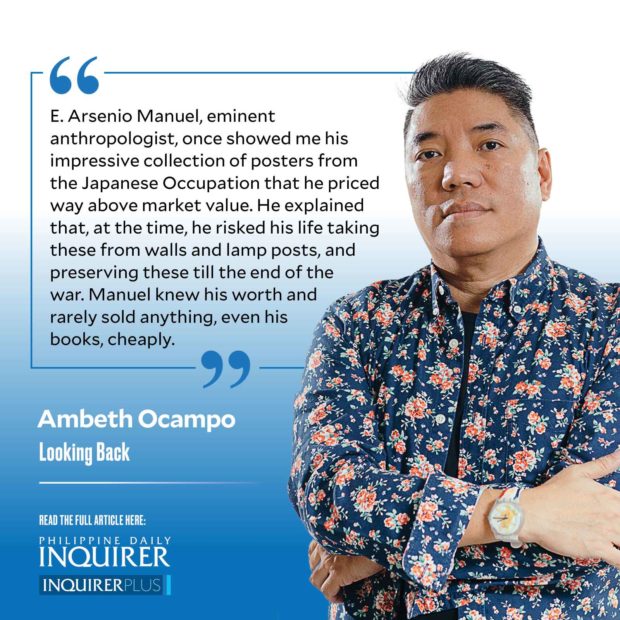Windows to the past
Wanted dead or alive” posters I have only seen in cowboy films and cartoons. While I have read and heard about “shoot to kill” orders for high-profile or dangerous criminals, I have never come across a physical wanted poster till this week. In a small exhibit of Philippine materials sourced from the University of Michigan’s various libraries and special collections was a poster that stood out from an assortment of postwar anticommunist or anti-Huk material. The banner for this poster screamed “PINAGHAHANAP PATAY o BUHAY.”
Being hunted were: Pedro Javier alias “Komander Kiko Jumarang,” Buenaventura Lion alias “Ka Ben” or “Ka Victor,” Anastacia (no surname) alias “Ester,” and Leonora Hipas alias “Linda.” Grainy black and white photos accompanied boxed descriptions and biographical information for each person of interest. It is significant that the men were wearing straw hats, while both women held rifles. Ester was aiming at something or someone, her finger poised on the trigger.
All fugitives in the poster were from Cavite, specifically Silang, Dasmariñas, and Naik. All were literate or what others would describe as “read and write” (nakakasulat at nakakabasa) in Tagalog; one was bilingual in Tagalog and English. Age, height, and weight were given, together with distinguishing physical marks: dark (maitim), fair (maputi), brown (kayumanggi), heavyset or could be fat (malusog at maaaring tumaba), and pockmarked (may bulutong). Disposition was also provided as: weak (mahina ang katawan), quick to anger (magagalitin), wandering (lagalag), always happy (laging masaya), quiet (tahimik), tomboyish (maypagka-lalaki), and friendly in happiness (magiliwin sa kasayahan). All of the above reminded me of the distinguishing physical features provided by the enemy during the Philippine-American War on a wanted person like Miguel Malvar that I have written about in this space before.
While I was happy these “ephemera” have been preserved, I was curious about who collected these and why? E. Arsenio Manuel, eminent anthropologist, once showed me his impressive collection of posters from the Japanese Occupation that he priced way above market value. He explained that, at the time, he risked his life taking these from walls and lamp posts, and preserving these till the end of the war. Manuel knew his worth and rarely sold anything, even his books, cheaply. This prompted his friend, the eminent Filipino historian Teodoro Agoncillo to laugh, explaining that Manuel wanted to recoup all his expenses down to the last Coke or food he ate 50 years later.
On the Japanese Occupation were now defunct newspapers like Daily News that printed “Extra” to herald breaking news. On Friday, Aug. 10, 1945, the headline screamed “JAPAN SURRENDERS.” Four days later, on Aug. 14, 1945, the headline reads “ JAPAN DEFINITELY SURRENDERS.” There were magazines edited and published by the Japanese propaganda office. Tagapagturo (Educator) was not for teachers but for religious. Historian Fumi Terada says this short-lived magazine was edited by a Japanese Protestant seminarian rather than a Roman Catholic. Filipina was a woman’s magazine with self-help or how-to articles, like “What to put in your evacuation balutan.”
A wartime go bag is slightly different from that recommended for an impending disaster in our future. For health recommended supplies were vitamins A, B, and C; disinfectants like Lysol, tincture of iodine or Mercurochrome, cotton, gauze, medicines included sulfanilamide, aspirin, quinine, cough medicine, and castor oil. Brandy was recommended, as well as paregoric, gentian violet, and argyrol. Clothing included warm night clothing, light night clothes, inner garments, working clothes, and even “Sunday clothes,” complete with veil, prayer book, and rosary.
All these printed primary source documentations were collected from the Philippines and made their way to the University of Michigan Library that is a veritable time capsule for historians. I am happy these materials are preserved abroad, and do not wish them to be physically returned to a climate bad for paper. Digital repatriation is the way to go. Once the originals are digitized and made available online, these materials will open more windows to our past.
—————–
Comments are welcome at aocampo@ateneo.edu





















